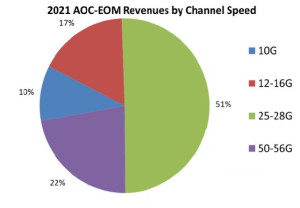 Optical interconnects have long served as data bridges between elements of large systems or clusters, and they’ve taken many forms. Since 2000, embedded optical modules (EOMs) have supported supercomputers, core routers, and an array of other interesting and unique applications. Active optical cables (AOCs) arrived in 2007 as a practical, low-cost alternative to regular pluggable modules, and found a home primarily in high-performance computing (HPC) clusters. The market for AOCs and EOMs has really been a collection of niches, which has made it lumpy and large-order sensitive. For example, combined market revenues fell 17% in 2013, and then recovered by the same percentage in 2014. With such a lumpy and variable past, what does the future hold?
Optical interconnects have long served as data bridges between elements of large systems or clusters, and they’ve taken many forms. Since 2000, embedded optical modules (EOMs) have supported supercomputers, core routers, and an array of other interesting and unique applications. Active optical cables (AOCs) arrived in 2007 as a practical, low-cost alternative to regular pluggable modules, and found a home primarily in high-performance computing (HPC) clusters. The market for AOCs and EOMs has really been a collection of niches, which has made it lumpy and large-order sensitive. For example, combined market revenues fell 17% in 2013, and then recovered by the same percentage in 2014. With such a lumpy and variable past, what does the future hold?
The analyst thinks the future for both AOCs and EOMs is bright, with the next two years marking a real departure from the past. They predict that the combined market will grow 48% to $262 million in 2015 and will go on to approach $850 by 2021. What is driving this change?
The general HPC market slump appears to be over, but the days of a single DARPA-supported IBM Blue Gene supercomputer needing 250,000 EOMs are over, and growth rates for the HPC segment going forward will be modest.
They are seeing some brand new opportunities, however, especially for EOMs. After being ‘the next big thing’ for some years, datacenter applications have finally arrived. Both AOCs and EOMs are included in the plans of some of the largest cloud-scale players. These customers buy large quantities and by the end of our forecast, will dominate unit shipments, admittedly at very competitive prices.
Just as pluggable optical modules are moving on from 10Gbps per lane to 25Gbps, so too are AOCs and EOMs. In fact, 25G EOMs are beating their AOC counterparts to revenue. 25G products will quickly become the core of the market. By 2019-2021, optical backplanes will become important and a new exascale supercomputer will be built, likely with 50Gbps optical technology.